MARY'S TRSAT
The Sanctuary of the Blessed Virgin Mary
The most significant sanctuary in Kvarner dedicated to Mary, and the oldest in Croatia, bases its
history on the transfer of the Nazareth House from the Holy Land on 10 May 1291 to Trsat, in
the Trsat Plains, and from here to Loreto, Italy, on 10 December 1294.
Mary’s Trsat has become, at the international level, the most recognized Croatian sanctuary in
the triangle Nazareth-Trsat-Loreto.
At the place where the Nazareth House existed, and later disappeared, the Frankopan princes of Krk
erected the church, which became the oldest Frankopan endowment and pilgrimage location...
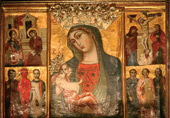 In 1367, Pope Blessed Urban V gave the inconsolable Croatian pilgrims a painting of the Mother
of God with baby Jesus.
In 1367, Pope Blessed Urban V gave the inconsolable Croatian pilgrims a painting of the Mother
of God with baby Jesus.
In the presence of a delegation of the Croatian Parliament, and based on a decision made by
the Vatican Chapter, the painting was crowned with two crowns in 1715; the first such example
recorded outside of Italy. In 1930, Pope Pius XI honoured the Trsat Church with the title of small
basilica (basilica minor). In its more than 700 year long history, the sanctuary has received numerous
letters and indulgences from various Popes; recently, Pope John Paul II made his pilgrimage to
the sanctuary.
The painting/icon of the Mother of God breastfeeding the dressed baby Jesus was ascribed as
the work of Saint Luke. Today, this painting’s exceptional artistic value has been ascribed to an
unknown master from the northern Mediterranean Venetian circles from sometime in the first
half of the 14th century.
The icon is kept in the Monastery treasury, while a replica, crowned with votive gifts, is kept in the
basilica immediately over the tabernacle at the main altar, and is considered to be the greatest
treasure of the Trsat sanctuary.
 Baroque stone-mason and painting works (Giovanni Pietro T. de Pomis, Father Serafin Schön,
Christophoro Tasca…) from the 17th and 18th century to all visitors and pilgrims. Works well worth
stopping before and looking at include the Altars of Saint Francis of Assisi, Saint Catherine, Saint
Michael, Saint John Nepomucene, Saint Nicholas, the Chapels of Saint Anne, Saint Peter the
Apostle, and Saint Anthony of Padua.
Baroque stone-mason and painting works (Giovanni Pietro T. de Pomis, Father Serafin Schön,
Christophoro Tasca…) from the 17th and 18th century to all visitors and pilgrims. Works well worth
stopping before and looking at include the Altars of Saint Francis of Assisi, Saint Catherine, Saint
Michael, Saint John Nepomucene, Saint Nicholas, the Chapels of Saint Anne, Saint Peter the
Apostle, and Saint Anthony of Padua.
The wrought iron railing surrounding the sanctuary is one of the most valuable works of Croatian
Baroque. The Stations of the Cross (Ivo Režek), stained-glass windows (Josip Botteri) and paintings
of the history of the Trsat sanctuary (Vladimir Kirin) were added to Our Lady’s sanctuary in the
twentieth century.
The Basilica is the burial grounds for the members of the Frankopan dynasty, heroes (Petar Kružić),
respectable families (della Rovere…) and several bishops and Franciscan monks from the Senj region.
Croatian Nazareth
Queen of the Adriatic
It is primarily a family sanctuary, known as the Croatian Nazareth. Everyday visitors are individuals, married couples, parents with children, and young couples. They come to Our Lady of Trsat in search of grace, perseverance, faith, and conciliation in hope and in prayer for the resolution of problems, for the forgiveness of sins, and for the realization of desires and expectations. Pope John Paul II also visited the Trsat sanctuary in 2003 in celebration and honour of the sacredness of family, under the motto “Family - the path of the Church and the people”.
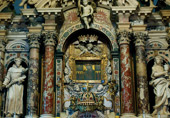 Trsat is also a sanctuary dedicated to Mary by seamen, the sanctuary of the Queen of the Adriatic
- Star of the Sea. It is a destination for many seamen and their families, where they give thanks
to Our Lady for "protecting, defending and bringing them home" in their inscriptions and prayers and thanks.
Trsat is also a sanctuary dedicated to Mary by seamen, the sanctuary of the Queen of the Adriatic
- Star of the Sea. It is a destination for many seamen and their families, where they give thanks
to Our Lady for "protecting, defending and bringing them home" in their inscriptions and prayers and thanks.
Mary's Trsat is visited by followers from all parts of Croatia, particularly residents of the coastal areas, mountains, foothills, islands – boduli, Lika, Istria... they come individually or in pilgrimage groups. Other visitors to the sanctuary include pilgrims from Slovenia, the Italian province Friuli- Giulia, and many foreigners and Croats from Europe, America, Australia...
Home of the Franciscan monks
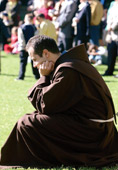 Upon receiving approval from Pope Nicholas V (1453), Prince Martin Frankopan built the Franciscan monastery next to the Church of Our
Blessed Virgin Mary which became the Franciscan centre of the Franciscan state.
Upon receiving approval from Pope Nicholas V (1453), Prince Martin Frankopan built the Franciscan monastery next to the Church of Our
Blessed Virgin Mary which became the Franciscan centre of the Franciscan state.
Over the past 550 years, inspired by the faith and protection of Our Lady of Trsat, in unity with the people, the Franciscans
impressed a mark of viability of Mary’s Trsat as a Croatian holy sanctuary.
Individuals who greatly contributed towards the realization of these goals included Franjo Glavinić (1585-1652), the constructor of the sanctuary and
monastery and the author of the first history of Mary’s Trsat Historia Tersattana (1648); Petar Francetić (1650-1725), who completed the
construction of the monastery and received approval from Pope Clement IX to supply the Trsat sanctuary with a new liturgy book and mass; Serafin
Schön (?-1642), the author of thirty-two frescos on Mary’s life, located in the large cloister in the monastery, as well as many other works, among which
are the well-known "Mystical evening of the Holy Family" in the summer dining hall of the monastery; and the Lord’s servant, Father Vendelin Vošnjak
(1861-1933), who invested great efforts to join Trsat to the Croatian Franciscan province (1900)...
The monastery library is filled with valuable items, manuscripts, chapters, books and musical scores. Of special note within the monastery are
the painted summer dining hall, the small cloister "hidden" by the monastery enclosures, the well-known and accessible large cloister,
and the recently constructed gardens dedicated to Mary, a space for great Eucharistic celebration or important musical events.
Near the gardens, on the Fortica hill, are the Stations of the Cross.
All this, and much more, are the permanent testimony of the valuable material and spiritual
achievements of the Franciscans in Trsat. The history of their Pastoral works and creations make
up the history of the Trsat sanctuary. This story is full of self-denial and sacrifice, the beauty of
space and spirit, closeness and warmth.
And indeed, there are few who do not feel at home in Mary’s Trsat among the Franciscans.
Everything here is "meant to fit the human heart", in the emotions and touch of noble virtues,
and in the inspirations and comprehension of true piety.
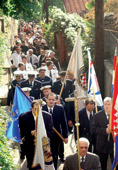 The Peter Kružić Stairs
The Peter Kružić Stairs
Allow me under the stairs of your holy
house
To cry once as a crazy child
For then the same, to me, in the slow
Walk which takes me into the heights,
Pain, that wilts with each step,
A flower that sprouts upon each stair.
Vladimir Nazor
Most pilgrims used to reach the sanctuary by stairs, and oftentimes even crawling on their knees. The well-known Trsat stairs is one of the most beautiful
monuments of Croatian devotion to Mary.
The stairs begin in the centre of Sušak, along the left bank of the Rječina River. They begin at the Chapel of Consolation for the Grieving, the Mother of
God with Jesus. There are over five hundred stairs that lead to the terrace before the church and end at the votive chapel constructed by Peter Kružić,
dedicated to the protector of seamen, Saint Nicholas.
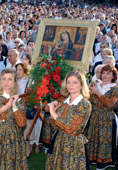 Today it carries the name Peter Kružić, the great Croatian hero who battled against the Turks and who is especially respected for his efforts
in defending the city of Klis. Peter Kružić made a pilgrimage to Trsat to thank Our Lady of Trsat for the victory.
In her honour, he constructed the first of 118 stairs (today there are 564) in 1513 which were later repaired and completed in 1726 by
Gabrijel Franjo Aichelberg, a military commander in Lika. Their merit is recorded in the passable colonnades – to Kružić at the
beginning of the stairs in Sušak, and to Aichelberg at the top of the stairs in Trsat.
Today it carries the name Peter Kružić, the great Croatian hero who battled against the Turks and who is especially respected for his efforts
in defending the city of Klis. Peter Kružić made a pilgrimage to Trsat to thank Our Lady of Trsat for the victory.
In her honour, he constructed the first of 118 stairs (today there are 564) in 1513 which were later repaired and completed in 1726 by
Gabrijel Franjo Aichelberg, a military commander in Lika. Their merit is recorded in the passable colonnades – to Kružić at the
beginning of the stairs in Sušak, and to Aichelberg at the top of the stairs in Trsat.
Even today, it is worthwhile visiting Trsat by stairs. However, it must be noted that due to the relatively steep ascent,
we do not recommend these stairs for persons suffering from medical problems.
An eternal votive gift
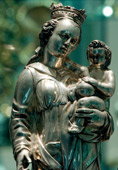 For centuries, the Trsat sanctuary has received votive gifts given by pilgrims in a display of gratitude
for all their answered prayers, miraculous salvations, deliverances and healings.
For centuries, the Trsat sanctuary has received votive gifts given by pilgrims in a display of gratitude
for all their answered prayers, miraculous salvations, deliverances and healings.
These gifts have been collected in a special chapel, the Chapel of Votive Gifts, in which the gifts, as testimony to the many perils and
weaknesses overcome by prayers to Our Lady, are protected under the smile of Our Lady of Slunj (15th century).
Gifts which suggest the value of artistic achievement in their quality and finesse are kept in the Treasury on the first floor of the monastery.
Kept here are the original painting/icon of Our Lady of Trsat (1367), and the remarkable reliquary of Barbara Frankopan (1476) with the
thirty-six holy powers and the silver statue of the Madonna with Child (1597), a gift from Toma Bakač Erödy.
There is also the oldest known copy of printed text in the Croatian language - the Heavenly Soul prayer book (1560).
The treasury of the Trsat sanctuary holds many other valuables and is worth a visit.
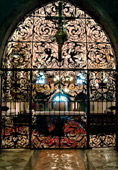 The interior of the Treasury and the chapel are not only determined by the physical, by their walls. Their spiritual space is determined by every
pilgrim’s visit and thought, their prayers, procession around the altars, bowings, each burning candle in the Chapel of Candles, each new
entry in the guest book in the Chapel of Votive Gifts, each gift and tranquillity in prayer, each request for forgiveness, comfort and hope...
The interior of the Treasury and the chapel are not only determined by the physical, by their walls. Their spiritual space is determined by every
pilgrim’s visit and thought, their prayers, procession around the altars, bowings, each burning candle in the Chapel of Candles, each new
entry in the guest book in the Chapel of Votive Gifts, each gift and tranquillity in prayer, each request for forgiveness, comfort and hope...
From the time of Nicholas I Frankopan to the arrival of Pope John Paul II, the Trsat sanctuary with its altars, altar walls, monasteries, gardens,
and stairs has been an eternal votive gift. Its strength is built on thanks and prayers made from all sides from which Trsat is visible or the bell
tower of Trsat, dedicated to Mary, is heard. The Trsat sanctuary are also all the oil lamps, calendars, pictures and prayer books in the homes of
the faithful which used to direct their thoughts to Our Lady of Trsat as a gift of sincere piety; in recommendation and thanks to the Blessed
Virgin Mary for generosity and advocacy, for moral strength, virtue and hope, for faith... A gift given in return for the joy of the ideal,
difficult, but right path.
Information:
Cloister open from 7:00 - 20:00
Store with paintings, candles and souvenirs open from 8:00-12:00 and from 15:00-19:00
Publications on the sanctuary: a range of numerous and valuable publications, we highly recommend the authors:
Father Bonaventura Duda, Father Emanuel Hošak, Radmila Matejčić, Vanja Vinković, Marijan Bradanović...
CD of the sanctuary: author Vanja Vinkovi}
Bulletin: Mary’s Trsat (four times a year- in May, August, September and December)
The Church is open daily from 6:30 - 19:30
Mass is held Monday to Friday at 7:00, 8:00, 9:00 and 19:00;
Sundays and holidays at 7:00, 8:00, 9:00, 10:00, 11:30 and 19:00
Confession is held from 7:00-12:00 and from 15:00-19:30
Visits and sightseeing of the treasury by appointment
Franciscan monastery
tel. 051/452 900
City of Rijeka Tourism Association
tel. 051/335 882
www.tz-rijeka.hr
tic@ri.t-com.hr,
tz-rijeka@ri.t-com.hr
Pilgrimages:
Each Saturday from May to late fall there are organized pilgrimages:
May
Franciscan youth (FRAMA)
10 May - Day of Our Lady of Trsat, Mother’s Day
Karlovac pilgrimage
Seamen’s pilgrimage (second half of May)
June
the votive pilgrimage of Grobnišćica
July
pilgrimage of Novi Zagreb
August
14 August, night pilgrimage
15 August - Feast of the Assumption, there is also a large fair at Trsat
pilgrimage of Bistrica
Pilgrimage of the faithful from the Bakar Bay inland
September
September 8 September-Nativity of the Virgin Mary
pilgrimage of the Poreč-Pula diocese
pilgrimage of the Zagreb Diocese
October
pilgrimage of the Krk Diocese
November
Rijeka pilgrimage - Thanksgiving
How to get to the sanctuary: Trsat stairs, bus, city bus routes 1 and 1A, automobile from centre of Rijeka or from Rijeka bypass
On the Feast of the Assumption, 15 August, Trsat is closed to automobiles.

